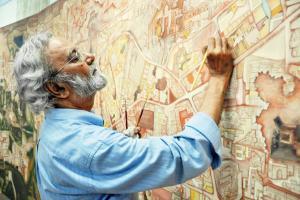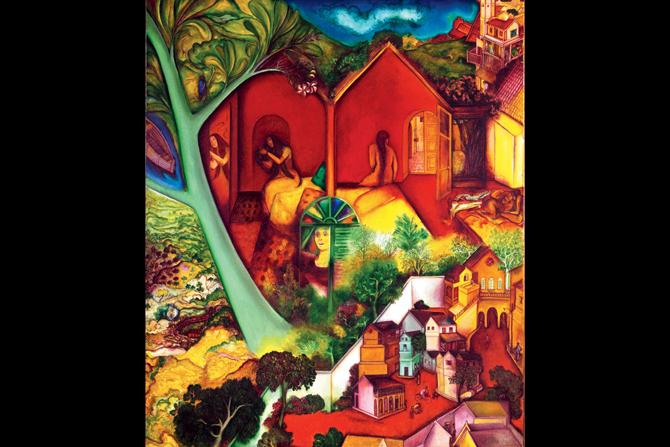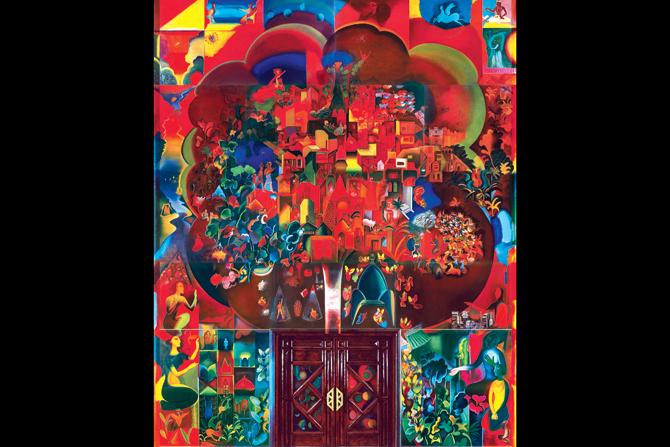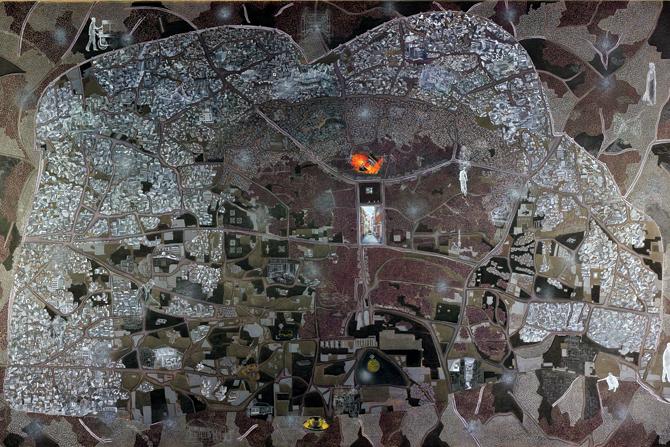To encapsulate six decades of artist Gulammohammed Sheikh's works, nothing less than a four-kilo doorstopper would do

Clockwise from above: Artist Gulammohammed Sheikh at work. Pic Courtesy/Bhavesh Patel
The editors of a new book on the art and life of Gulammohammed Sheikh, At Home In The World, which is heavier than a newborn, were compelled to stop when they crossed 450 pages. Because Sheikh, who has been awarded the Padma Shri and the Padma Bhushan, and is "one of the foremost artists of his generation," according to fellow artist and overachiever Gieve Patel, has been at the drawing board for 60 years.
ADVERTISEMENT
"At one point, it looked like the book was going to become three volumes," says its editor, Chaitanya Sambrani. "The number of pages, images and words was just becoming unmanageable. When a career is this long and distinguished, it isn't easy to compress it into the space of one volume." The tome, as accurately described by Kiran Nadar, Sheikh's biggest collector, is "a 60-year retrospective in a book." The book will be released by doctor-artists Sudhir Patwardhan and Patel at Jnanapravaha Mumbai on March 30.

About Waiting and Wandering, 1981
The youngest of five, Sheikh grew up in Gujarat, when its maiden name was still Saurashtra. "It was a backward area where we lived [in Surendranagar]," he says. "My father educated all his children, [even though in] our community, there was little education." From 1955-61, Sheikh learned how to paint at MS University of Baroda; from 1982-93, he taught how to paint at MS University of Baroda. In the interim, he studied at Royal College of Art, London, gave lessons in art history at MS for 15 years, and wooed and wedded one of his students, the celebrated artist Nilima. "I was an untutored art historian," he says. "I had to develop my own mode of teaching art history, so I taught it as an artist. In order to teach, you have to learn double of what you give to students. That enabled me to look deeper, closer and more intensely into the nature of my work. When I began to see paintings in this manner, it became about holding the painting in my hand, entering it and discovering its various nooks and crannies."

Tree of Life, 1996, at the Madhya Pradesh Vidhan Parishad
Incidentally, this is the way to read Sheikh's busy works as well. Several of Sheikh's canvasses resemble the hotchpotch of Indian cities, with references to Indian history, geography and mythology daubed together. On one of Sheikh's landmark works from 1981, About Waiting and Wandering, Sambrani says, "There is a kind of mythologised personal history with images of family members, architectural features of the university and colonial Baroda, images of the dry riverbed landscape in which he grew up in Surendranagar, and images of a part-imagined, part-real cityscape. They all come together in this glowing, warm kaleidoscope of references. It's a painting that sums up a number of his concerns up until that time." The organised chaos is the reason several paintings in the book are bookended by close-ups. Just like god, Sheikh's art lies in the details.

Ahmedabad: The City Gandhi Left Behind, 2016
In oils, water colours, pastels, gouache, acrylic, casein, pigments and digital prints, Sheikh creates collages of the world. "In the 1970s, I began to use multiple and disparate images in a single frame, and that remained my preoccupation for a long time," he says. Up till the 1980s, in fact. Sambrani says, "He has internalised the lessons of looking at Persian painting, at early Italian Renaissance, at the Mughal and Rajasthani miniature traditions, and combined them with an understanding of abstraction. [For two decades], he developed a mode of art-making that, in the trade, is known as narrative figuration. It deals with the abundance of images that surrounds us in our lives, all kinds of experiences, from deeply personal ones to extremely political ones, and tries to embrace that entire gamut of human experience through figurative imagery. So, through telling stories, and trying to understand the importance that narrative has had in the development of human culture, [he shows that] we are human only because we have the ability to tell stories, to make stories."

Chaitanya Sambrani, editor
A canvas can be limiting for an ambition of this scale, which is why one of Sheikh's most important works is on an 8.5-metre wall. In 1996, Sheikh was commissioned to create a mural for the Madhya Pradesh Vidhan Parishad. "The Tree of Life is like a visual encyclopaedia of central India," says Sambrani. "It has references to various mythologies from Madhya Pradesh, such as the Singhasan Battisi, of Vikram and Betaal; commentaries on recent events, such as the Union Carbide disaster; and salutes to great poets, literature, and architecture: the temples, mosques and palaces. On either side of the door, there are reminders to the legislators of what their responsibilities are. In the Singhasan Battisi, you are not allowed to sit on the throne of power until you have proven yourself. There is an amazing coming together of contemporary politics alongside a deep sense of the history of the region."
That has been one of Sheikh's broad strokes: braiding archival events with current events. Nadar, who owns an Emergency-era work called Speechless City, was drawn to his art because, "He sees the hidden political issues in our lives and portrays them beautifully." Patel says, "His work is touched by his personal experiences of living in India at this time in history." Sambrani adds, "There has been an increasing anguish and response to some of the developments that have taken place in our politics [in his works]: from the demolition of the Babri Masjid in 1992 to the riots in Gujarat in 2002, and everything else that has happened in recent years that has [created] problems to the foundations of the secular republic of India." For instance, a 2016 work, Ahmedabad: The City Gandhi Left Behind, is a massive (2m x 3.5m) monochrome, with a burning autorickshaw, an enduring image from the Gujarat riots, and five belongings of the Mahatma, scattered in a pol in central Ahmedabad.
"This pol would normally be full of people, cows, goats, cycles," says Sambrani. "But, it is completely deserted. The city is like a city of ghosts." It takes great clarity for an artist to see the wrongs and the rights of the world and join them at the hip. After 60 years, Sheikh can do so with his eyes closed.
Catch up on all the latest Mumbai news, crime news, current affairs, and also a complete guide on Mumbai from food to things to do and events across the city here. Also download the new mid-day Android and iOS apps to get latest updates
 Subscribe today by clicking the link and stay updated with the latest news!" Click here!
Subscribe today by clicking the link and stay updated with the latest news!" Click here!






